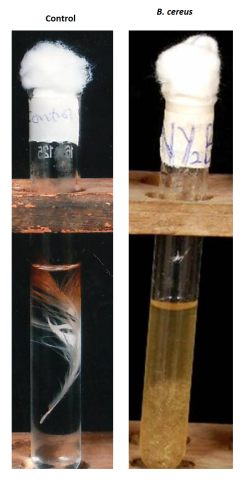Feather Degradation by Bacillus cereus LAU 08
Feather Degradation by Bacillus cereus LAU 08
Our journey on studies on microbial keratin degradation started around 2008 through series of investigations. In 2010, we reported the keratinolytic activities of a strain of Bacillus cereus as follows:
A local strain of Bacillus cereus LAU 08 was isolated from a chicken-feather disposal site in Ogbomoso, Southwest Nigeria. Production of keratinase was induced using three sources of keratin, namely: hooves, horn, and feather, at a growth temperature of 37 °C. In each case, high titers were recorded for both keratinolytic and proteolytic activities. Maximum enzyme activities were obtained within 24–96 h of cultivation, depending on the keratin substrate used and the activity under study. While maximum keratinolytic activities of 67.9, 63.1, and 51.7 U ml−1 were obtained using enzymes induced by hooves, horn, and feather, respectively, proteolytic activities of 11 860, 820, and 126 U ml−1 were obtained using enzymes induced by feather, hooves, and horn, respectively. The optimal conditions for the keratinolytic activity were determined to be pH 7.0 and temperature of 50 °C; however, the enzyme displayed more than 50% activities within the broad range of pH 7–9 and temperature of 40–70 °C. In addition, the isolate was able to completely degrade a whole chicken feather within a period of 7 days at room temperature (30 ± 2 °C). B. cereus LAU 08 is therefore a promising strain for the management of chicken feather waste through biotechnological processes.
Published in International Biodeterioration and Biodegradation: Link


